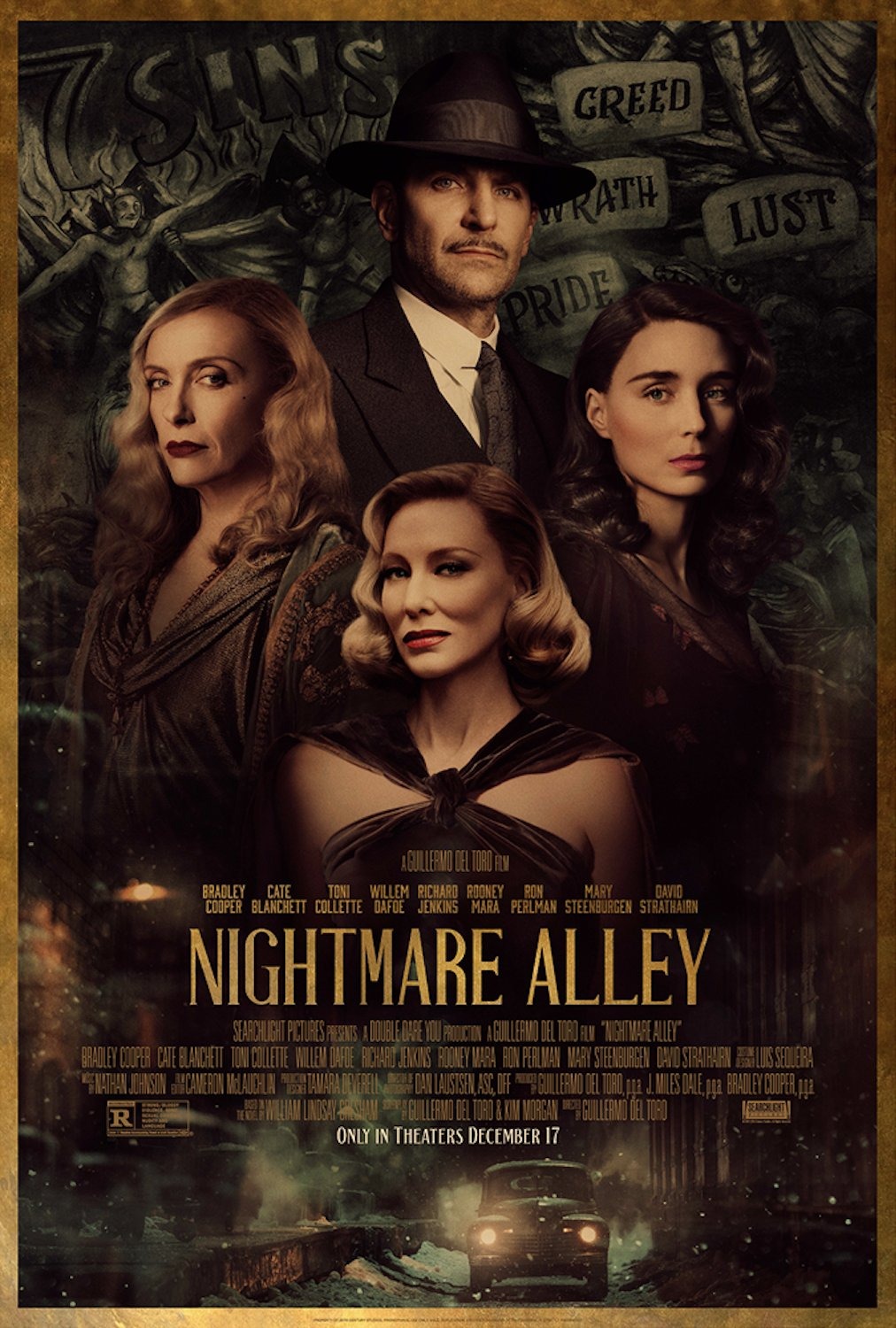Nightmare Alley
Director: Guillermo del Toro
Nightmare Alley, Guillermo del Toro’s eleventh film, is a masterful neo-noir psychological thriller starring Bradley Cooper (Stan Carlisle) and Cate Blanchette (Dr. Lilith Ritter), and a jaw-dropping ensemble supporting cast. It’s a new adaptation of William Lindsay Gresham’s 1946 novel. Edmund Goulding adapted the novel as a classic film noir in 1947. All three pieces have the same title. Taking place in the Midwest during the Depression, the name reminds of us a dark, dangerous location, off the main street, where nightmares are reality: Illegal abortions performed; the homeless and destitute seek shelter; addicted prostitutes earn their living; and the physically and intellectually disabled hide away from the brutality that society perpetrates on them, in hopes of being found and hired by a traveling carnival sideshow manager.
As the film opens, Stan is dragging a large bundle across a field to his house, which he burns to the ground. On the lam to avoid being caught for the arson, he is soon hired to work in a traveling carnival by its owner Clem (Willem Dafoe). Life as a carny suits Stan. Clem’s sideshow is the big draw, and he staffs it with the physically disabled and drug addicts. The biggest junkies become Geeks, among the show’s headliners, who bite the heads off live chickens. Other acts are: Madame Zeena (Toni Collette), a clairvoyant with the aid of her husband Pete’s (David Stratham) complex system of verbal & visual codes, which he teaches to Stan; and Molly Cahill (Rooney Mara), who uses Tesla Globes to convince audiences that she can channel electricity. Stan falls in love with Molly, and when Pete suddenly dies, he convinces Molly to leave the carnival and accompany him as his assistant in a traveling clairvoyant act. At that point, the film takes a sudden, striking Act II that I’ve not seen since Stanley Kubrick’s 1987 masterpiece, Full Metal Jacket. In Act II, we meet Dr. Lilith Ritter, the film’s femme fatale. She is a psychiatrist for the super-rich who becomes Stan’s therapist. Lilith seduces Stan and his lust for sex, money and power, and his path as a con man takes a turn down a dark, evil rabbit hole. He stops doing shows for audiences to becomes a personal seer for the grieving rich, against Molly’s objections, manipulating her to stay in a show she detests.
It is not just Stanley Kubrick, one of Guillermo biggest influences, that is tributed in Nightmare Alley; nor is Full Metal Jacket’s structure his only homage to Stanley. There are scenes reminiscent of The Shining’s long Kubrickian hallways. Soon after the first act begins, you realize Something Wicked This Way Comes. Alfred Hitchcock’s influence is even more prominent than Kubrick’s in Nightmare. Stan’s Freudian psychoanalysis sessions with Lilith remind us Spellbound, this reviewer’s favorite Hitchcock movie; and there’s a scene where the eyes on the walls of the Dali-designed Dream Sequence in Spellbound is mirrored. The carnival marquees in Hitch’s Strangers on a Train and Nightmare Alley are very similar. In an interview with Collider.com, Guillermo says, “…it’s the exact same marque [sic]”. Further, there are bizarre funhouse mirror scenes in both. Spellbound and Strangers are both film noirs.
Nightmare Alley is a neo-noir, or a new noir, a variant of film noir, French for “black movie”, although ”dark movie” is more accurate. What constitutes classic film noir has long been debated. To me, it’s a tragedy where the protagonist is a normal, law-abiding man who, through unforeseen circumstances finds himself involved in a serious crime. The genre is crime drama tragedy where the protagonist is male who becomes involved in a crime as a result of circumstances over which he has little or no control. Other recurring characteristics: Black & white cinematography with interesting camera angles; retrospective protagonist narration; the protagonist is an anti-hero; and the female lead is a femme fatale (French for “fatalistic woman”), who helps bring about the protagonist’s tragedy. Nightmare Alley contains some but not all of these characteristics. But because Stan can in no way be described as a law-abiding citizen, the film is not a classic film noir. Although it’s playing now in cinemas only, all cinemaphiles should see this great neo-noir, especially if you’re not a fan of contrived happy endings.
Paul hosts The Hub on Canal’s Art in the Form of Film, and Broadway at the Hub series. The Hub on Canal is a non-profit art gallery/collective on Canal Street, NSB.


